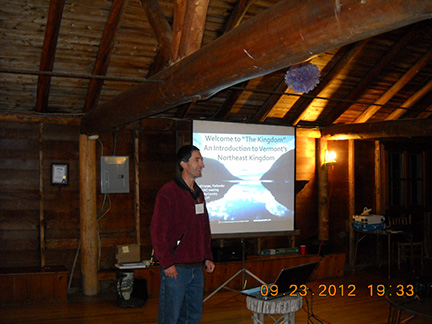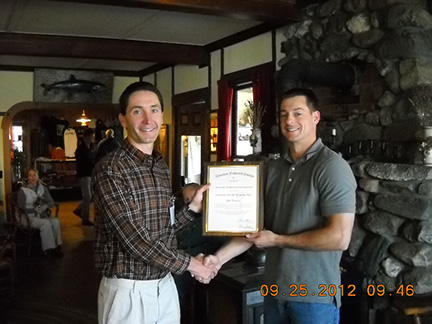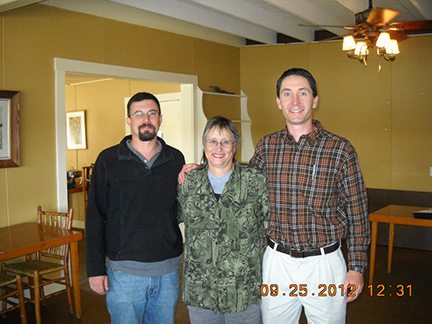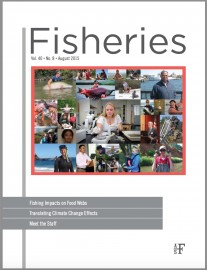38th Annual Meeting of the
Atlantic International Chapter of the American Fisheries Society
September 23-25, 2012
Averill, Vermont
Download Summary of Conference:
• AIC Conference 2012 (PDF)
• AIC Conference 2012 (DOC)
2012 AIC Business Meeting Minutes
Hotel Information
Quimby Country Lodge and Cottages
Quimby Country Lodge & Cottages
P.O. Box 20
Averill, VT 05901
Conference Schedule
| Sunday, September 23rd | |
| 3:00 pm – 7:00 pm | Registration |
| 7:00 pm – 9:30 pm | Sunday Evening Session and Social – Free beer while it lasts |
| Moderator – Jud Kratzer – Vermont Fish and Wildlife | |
| Jud Kratzer – Introduction to Vermont’s Northeast Kingdom | |
| John Magee – New Hampshire’s Experience with Fish Habitat Projects in Lakes | |
| Joan Trial – Removing a remnant log drive dam? | |
| Len Gerardi – Observations of curious climbing behavior of dace, genus Rhinichthys, with implications for design of aquatic organism passage through box culverts and other structures | |
| Open Mic – Informal presentations to share current projects with attendees | |
| Monday, September 24th | |
| 7:00 am – 8:00 am | Breakfast |
| 7:00 am – 8:10 am | Registration |
| 8:10 am – 8:30 am | Welcome and Introductions |
| 8:30 am – 9:10 am | Keynote Speaker : Donna Parrish – Migration of Atlantic salmon smolts in the Connecticut River |
| Fish Assemblages Moderator: Kathryn Collet – New Brunswick Department of Natural Resources-Fisheries |
|
| 9:10 am – 9:30 am | Graham Goulette – Predation and prey buffer potential for Atlantic salmon smolts emigrating the Penobscot Estuary, Maine |
| 9:30 am – 9:50 am | Justin Stevens – What’s in the Water? – Penobscot Estuary Fish Community Survey Preliminary Results |
| 9:50 am – 10:10 am | Michael Bailey – DIDSON Assessment of Fish Approaching an Hydroelectric Dam |
| 10:10 am – 10:30 am | Coffee Break |
| Habitat Restoration Moderator: Ernie Atkinson – Maine Department of Marine Resources |
|
| 10:30 am – 10:50 am | Rich Kirn – Impacts to Stream Habitat and Wild Trout Populations in Vermont following Tropical Storm Irene |
| 10:50 am – 11:10 am | Joe Norton Indian Stream Fish Habitat Restorations, Its History, Problems, and Solutions |
| 11:10 am – 11:30 am | Kenneth Cox – Trout Population Response to Cover Habitat Enhancement in the Batten Kill Main Stem |
| 11:30 am – 11:50 pm | Jim MacCartney – Mobile wood additions: an effective tool for restoring channel complexity and salmonid habitat |
| 12:00 pm – 1:30 pm | Lunch |
| Fisheries Management Moderator: Dana Degraff – Maine Inland Fisheries and Wildlife |
|
| 1:30 pm – 1:50 pm | Brian Chipman – Lake Champlain salmonid restoration and management |
| 1:50 pm – 2:10 pm | Bill Ardren – Landlocked Atlantic Salmon Restoration in Lake Ontario and Lake Champlain |
| 2:10 pm – 2:30 pm | Ernie Atkinson – Maine’s Experience with Captive Reared Adult Atlantic Salmon Outplants |
| 2:30 pm – 2:50 pm | Colby Bruchs – Movement, spawning, and overwinter habitat of captive reared Atlantic salmon (Salmo salar) out-planted in a spawning stream |
| 2:50 pm – 3:10 pm | Coffee Break |
| Partnerships Moderator: Doug Smithwood – US Fish and Wildlife Service |
|
| 3:10 pm – 3:30 pm | Ernie Atkinson – NGO’s and Government Agency Partnerships examples from Eastern Maine |
| 3:30 pm – 3:50 pm | Steven Koeing – Project SHARE’s Focus Area Approach to Salmonid Habitat Restoration: The Results Following Five Years of Implementation |
| 6:00 pm – 8:00 pm | Dinner and Social |
| 9:00 pm – 10:30 pm | Campfire |
| Tuesday, September 25th | |
| 7:00 am – 8:00 am | Breakfast |
| 8:00 am – 10:00 am | BUSINESS MEETING |
| 10:00 am – 10:20 am | Coffee Break |
| Species focus Moderator: Joan Trial – Maine Department of Marine Resources |
|
| 10:20 am – 10:40 am | Gabe Gries – An evaluation of the 1998 walleye slot length limit regulation on the Connecticut River |
| 10:40 am – 11:00 am | Jud Kratzer – Brook Trout Biomass Limiting Factors in Northeastern Vermont Streams |
| 11:00 am – 12:00 pm | Raffle, Silent Auction Winners, Soggy Boot Award, Lunker Award, Wrap Up |
| 12:00 pm – 1:30 pm | Lunch |
Abstracts/Presentations
Primary Author:
John Magee
New Hampshire Fish and Game Department
[email protected]
Contributor:
Gabe Gries, New Hampshire Fish and Game Department
Title: New Hampshire’s experience with fish habitat projects in lakes
The New Hampshire Fish and Game Department is very interested in actively improving fish habitat in lakes by means of adding trees. Recently, the Department received a permit to do just this, using Christmas trees, in one water body in southern New Hampshire. We would like to share with you our experience in developing the project, including educating the public, lake shore owners, the town conservation commission and other state agencies. We plan to implement the project in late 2012.
Primary Author:
Joan Trial
Maine Department of Marine Resources
[email protected]
Contributors:
Ben Naumann, USDA
Colby Bruchs, USDA
Title: Removing a remnant log drive dam?
Remnant dams from log drive days are scattered throughout Maine watersheds, all impound water and many block passage during low flows. Picking them out from aerial photography is relatively easy. Taking them out requires a willing landowner, bit of planning, good mechanical advantage, manual labor, and documenting the site for the State Historic Preservation Office.
Primary Author:
Graham S. Goulette
NOAA National Marine Fisheries Service
[email protected]
Contributors:
James P. Hawkes
Michael B. O’Malley
John F. Kocik
Paul M. Music
Justin R. Stevens
Christine A. Lipsky1
Title: Predation and prey buffer potential for Atlantic salmon smolts emigrating the Penobscot Estuary, Maine
Many Atlantic salmon populations are at historic low abundance; a leading hypothesis explaining this factor is mortality experienced during ocean entry. We have used acoustic telemetry to further our understanding of causes behind these early losses and smolt ecology. Our work in the Penobscot River’s Estuary and Bay since 2005 has evaluated nearshore migration performance and survival of smolts from river release points 90km outward to the Gulf of Maine. These studies identified specific patterns of smolt behavior and areas of high smolt mortality. High smolt mortality in the upper estuary (10-25%) and bay (15-35%) may be influenced by the co-occurrence, abundance, and size composition of resident and migratory species, including river herring and American shad, which serve as alternate prey for marine predators. More recently, we have combined our telemetry results and estuary survey data to further our knowledge of the ecosystem and how it relates to salmon survival. Saunders et al. (2006) hypothesized that a healthy, more robust diadromous community in rivers and estuaries of Maine should reduce predation on emigrating smolts through predator satiation or predator swamping. Direct observation of these communities and knowledge of the temporal and spatial distribution of predators and prey will help to better understand salmon community ecology, and ultimately the effect of predation on Atlantic salmon smolt populations in the Penobscot estuary.
Primary Author:
Justin Stevens
NOAA National Marine Fisheries Service
[email protected]
Contributors:
Michael O’Malley
Rory Saunders
Christine Lipsky
John Kocik1
Title: What’s in the Water? – Penobscot Estuary fish community survey preliminary results
Scientists at NEFSC’s Maine Field Station have initiated a comprehensive survey of the Penobscot Estuary which includes monitoring components of the fish, marine mammal, and avian communities, and monitoring water quality. The overall goal of the survey is to aid in our understanding of the environment utilized by endangered Atlantic salmon during their immigration and emigration through estuarine and near shore environments. One component of the survey involves surface trawling in the estuary using a modified pelagic trawl. We present preliminary findings of fish community structure and changes in the relative abundance of fish species in space and time with applications for future research.
Primary Author:
Ann B. Grote
University of Maine, Department of Wildlife Ecology
[email protected]
Contributors:
Joseph D. Zydlewski, University of Maine, Department of Wildlife Ecology
Michael M. Bailey, U.S. Fish and Wildlife Service
Title: DIDSON Assessment of fish approaching a hydroelectric dam
Although American shad were historically abundant in the Penobscot River, Maine, the current population is poorly characterized and presumed to be small. Implementation of the Penobscot River Restoration Project, including the upcoming removal of Veazie Dam, is expected to improve marine-freshwater connectivity and facilitate American shad recovery throughout this system. A major question surrounding shad restoration is whether the current run approaches Veazie Dam and is therefore available to recolonize upstream habitats post dam-removal. In the spring of 2011, we surveyed migratory fishes approaching Veazie Dam using Dual Frequency Identification Sonar (DIDSON). This work was conducted in turbulent water below the dam, making automated data processing unfeasible and requiring a team of readers to manually review the footage and measure fish. Data from a 5% subsample of DIDSON files described length distributions for imaged fish, and a Bayesian mixture model was used to apportion fish observations by species. This approach enabled us to address measurement effects between readers, and to incorporate known size distributions for several Penobscot River fishes. Preliminary results indicate DIDSON was an effective tool for making species determinations, and that a large percentage (76.2%) of fish encounters at the base of Veazie Dam were American shad.
Primary Author:
Rich Kirn
Vermont Fish and Wildlife Department
[email protected]
Title: Impacts to stream habitat and wild trout populations in Vermont following tropical storm Irene
Damage suffered from Tropical Storm Irene required immediate and in some cases extensive stream channel alteration to protect life and property and rebuild critical transportation infrastructure. However, a significant amount of instream activity was also conducted without proper consultation and oversight or for reasons beyond necessary flood recovery. These activities continued for several months after the flood event and covered a wide area of the central and southern portion of the state. Post-flood activities which were detrimental to aquatic habitat quality and diversity included large scale removal of streambed material and natural wood, berming of streambed materials to raise streambank elevations and the straightening of stream channels. These activities resulted in homogeneous, overwidened stream channels comprised of small substrates and lacking the diversity of habitats, flows and depths necessary to support robust aquatic populations. As fish population recovery and fisheries management options will be dependent on aquatic habitat quality and complexity, the Vermont Department of Fish and Wildlife conducted an assessment of post-flood aquatic habitats in selected watersheds. This partial assessment estimated a total of 77 miles of stream with major degradation of aquatic habitat resulting from post-flood stream channel alteration activities. Improvements in post-flood response regulations, policies and procedures as well as effective use of internal staff and outside expertise will be necessary to minimize unnecessary degradation of stream channels and aquatic habitats following major flood events. More importantly will be the need to minimize future conflicts between the built and stream environments by ensuring that future development is compatible with the hydraulic, geomorphic and ecological processes of Vermont’s streams and rivers.
Primary Author:
Joe Norton
Trout Unlimited
[email protected]
Title: Indian Stream fish habitat restorations, its history, problems, and solutions
Trout Unlimited has over twenty Home Rivers Initiatives in the United States. The Upper Connecticut Home Rivers Initiative was launched in 2008 and encompasses the Upper Connecticut River watershed and more than 19 major tributaries in NH, Vermont, and Canada, from Lake Francis in Pittsburg NH to the confluence of the Upper Ammonoosuc River in Groveton NH. The Upper Connecticut River is home to native brook trout and natural brown trout and rainbow trout, and is the largest watershed in New England. It’s one of only 14 American Heritage Rivers in the United States and in 2012 became the first National Blueway River in the country.
Indian Stream at 70.8 sq. mi. is one of the larger tributaries in the watershed and is the uppermost in the project area. Damage to Indian Stream from poor logging practices began with intensive logging and the log drives from 1867-1914 and continued through the 1980’s. Like many larger Upper Connecticut tributaries, the forested areas were heavily cut, the channel was straightened, instream boulders and riparian vegetation was removed, side channels were blocked, and dams were built throughout the watershed. This damage exists to this day. Many reaches are wide, straight, shallow, scour repeatedly, lack woody material, and have temperature concerns. Indian Stream’s smaller nursery streams have good habitat and very good trout populations, but many of them have poor crossings. Its three major branches, the East, Middle, and West, generally have poor instream habitat but good buffers, however mature trees are not yet contributing to the stream. Wood additions are the primary restoration technique in the branches. Ongoing and future restorations include chop & drop and mobile wood additions, strategic crossing replacements, and instream and edge structure restorations like boulder and root wad clusters, rock weirs, and engineered log jams.
Primary Author:
Kenneth M. Cox
Vermont Fish and Wildlife Department
[email protected]
Title: Trout population response to cover habitat enhancement in the Batten Kill main stem
Trout population response to the addition of cover structures in a section of the Batten Kill main stem was evaluated. Prior to treatment available fish cover for yearling and larger size trout in the habitat enhancement project site was estimated to be 0.7% of the wetted channel area. Placement of 85 cover structures increased available cover to a modest 3.0%. Trout abundance prior to and following habitat enhancement was estimated by annual electrofishing surveys conducted within pool and riffle habitats in the treatment section as well as at two untreated control sites. While no change in mean yearling trout numbers was observed between pre- and post-treatment periods at the control sites, average yearling fish numbers increased 4.9 fold in the treated pool and doubled in the treated riffle. In the pool habitat young-of-year trout numbers also doubled and modest increases in the range of 1.6-1.8 times pre-treatment levels for fish in the 10-19.9 inch adult size range were observed. These results provide evidence that inadequate refuge habitats may be limiting trout abundance in the Batten Kill. Habitat restoration may be an effective management tool to compensate for factors affecting trout survival and abundance, although cost and access to private lands limit its practicality on a watershed scale. Protection and restoration of riparian habitats and its influence on instream habitats will be key to the long term health of the Batten Kill wild trout resources.
Primary Author:
Jim MacCartney
Trout Unlimited
[email protected]
Contributors:
John Magee
John Field
Title: Mobile wood additions: an effective tool for restoring channel complexity and salmonid habitat
Wood is an important, natural component in many river systems. Often, it is one of the largest structural elements and, as such, influences a variety of characteristics including channel morphology, flow complexity, particle size segregation, habitat diversity, cover availability, and nutrient retention. River restoration practitioners are increasingly adding large wood to address shortages resulting from anthropogenic and other impacts. However, few practitioners employ mobile wood additions; most intend for the wood to be stationary, and many use various anchoring methods to hold it in place. While both approaches are effective restoration techniques, our research found that mobile wood more closely mimics natural recruitment to—and transport and accumulation within—river systems and provides a cost effective method of producing desired results in hard-to-reach or inaccessible locations. Trout Unlimited and its partners are pioneering the use of mobile wood additions to restore instream and riparian habitat at Nash Stream—a glaciated, forested watershed in northern New Hampshire that was radically altered by a catastrophic dam breach in 1969. The authors discuss application of this technique on mid-sized rivers (2nd to 4th order) in rural landscapes with temperate climate regimes. We describe how we selected locations for mobile wood additions, what tree species and diameters we used, the installation techniques and associated costs, the density and elevation of loadings, and the methods that we used for tagging and tracking trees. We also present two years of monitoring results that describe the discharges that moved wood, typical distribution patterns and retention points, distances travelled, root orientation, elevation relative to bankfull, effects of beaver activity, and the lessons learned.
Primary Author:
Brian Chipman
Vermont Fish and Wildlife Department
[email protected]
Contributors:
Bill Ardren
Henry Bouchard
Kevin Kelsey
Chet MacKenzie
Bernie Pientka
Bill Schoch
Steve Smith
Nick Staats
Title: Lake Champlain salmonid restoration and management
Landlocked Atlantic salmon (LAS) and Lake Trout (LKT) are an important part of the Lake Champlain ecosystem and fishery. Native LAS and LKT were extirpated in the Lake Champlain basin in the 1800’s. Restoration of Lake Champlain salmonid fisheries was initiated in the 1970’s through coordinated annual stocking of hatchery fish by Vermont, New York, and the US Fish and Wildlife Service. Several strains of each species were stocked and evaluated. Seneca strain LKT was selected for continued stocking in 1985, and a “Lake Champlain” strain developed from feral spawners (predominately Seneca strain) has also been stocked since 1990. Adirondack, Memphremagog, and Sebago LAS strains have been stocked since the late 1990s, and hatchery production is phasing in to all Sebago strain, based on its stronger tributary returns in recent evaluations. Annual salmonid assessment sampling largely involves fall tributary and nearshore electrofishing, and fishway monitoring. Sea lamprey parasitism is a major factor limiting salmonid survival in Lake Champlain. Following successful experimental sea lamprey control in the 1990’s, a long term, integrated sea lamprey control program was developed and subsequently initiated in 2002. There is a strong relationship between reduced sea lamprey abundance and increased salmonid survival and adult returns. Popular lake fisheries have developed from restoration efforts; however, tributary LAS fishing opportunities are limited due to relatively few returning in spawning runs. Other issues include successful LKT spawning but a lack of recruitment beyond the fry stage; limited LAS spawning habitat; and forage base instability following the invasion of alewives. On-going fish passage and riparian habitat restoration efforts are improving LAS access to suitable spawning habitat. New initiatives include developing metrics to assess stocking rates, evaluations of LAS hatchery products, and research to optimize LAS culture conditions and stocking strategies to enhance survival, improve imprinting, and increase adult returns.
Primary Author:
William Ardren
US Fish and Wildlife Service
[email protected]
Contributors:
Tom Stewart
James H. Johnson
Title: Landlocked Atlantic salmon restoration in Lake Ontario and Lake Champlain
Lake Ontario and Lake Champlain once supported some of the largest populations of landlocked Atlantic salmon (LAS) in the world. Dams, habitat destruction, overfishing, and pollution caused the extirpation of LAS in both lakes approximately 150 years ago. Past LAS restoration attempts failed due in large part to changes in forage base, sea lamprey predation, poor access to spawning areas, thiamine deficiency caused by eating non-native alewife, and interactions with non-native salmon. The recent combination of effective sea lamprey control, improved fish passage, enhanced stream habitat, and reduction in alewife numbers in Lake Ontario provide new LAS restoration opportunities. Current restoration efforts have resulted in hatchery-origin LAS spawning in multiple rivers in both lakes with successful natural recruitment documented annually since 2009 in the Salmon River of Lake Ontario. Many challenges still remain to restore self-sustaining populations of LAS in both lakes, including the introduction of alewife to Lake Champlain in 2003. We will discuss ongoing adaptive management experiments in the lab and field focused on optimizing hatchery practices to enhance survival, improve imprinting, and increase adult returns of hatchery fish used for LAS restoration.
Primary Author:
Ernie Atkinson
Maine Department of Marine Resources
[email protected]
Contributors:
Colby Bruchs
Paul Christman
Title: Maine’s experience with captive reared adult Atlantic salmon outplants
Stocking strategies to restore endangered populations of Atlantic salmon (Salmo salar) within the Gulf of Maine DPS have used all hatchery life stages available; fry, parr, smolt, egg, and gravid adults. Management focusing on fry stocking has not resulted in significant adult returns and natural reproduction. Stocked smolts produce large returns but the long term benefits are unknown. Adult stocking circumvents much of the hatchery influence on mate selection and potentially results in progeny that are more likely to survive and reproduce in the wild. However, stocking adults sacrifices numerical production advantages achieved by traditional hatchery methods. In 2005 an adaptive management project began in selected streams in which river-specific Atlantic salmon adults, reared to maturity from large parr captured in the rivers, were stocked in the autumn. This work has expanded to other streams and includes investigations into movements, redd construction rates, site fidelity, and vital rates. Stocked adults successfully spawned producing juvenile Atlantic salmon. From acoustic telemetry gear we learned there was high fidelity to the release location at spawning. Juvenile assessments documented that 0+ and 1+ parr densities were similar to densities in fry stocked areas. Managers need to consider lifetime fitness in evaluating large scale gravid adult outplanting projects.
Primary Author:
Colby Bruchs
Maine Department of Marine Resources
[email protected]
Contributors:
Ernest Atkinson
Joseph Zydlewski
Denise Buckley
Title: Movement, spawning, and overwinter habitat of captive reared Atlantic salmon (Salmo salar) out-planted in a spawning stream
Out-planting gravid adult Atlantic salmon (Salmo salar) to populate target reaches with juveniles produced from natural spawning is increasingly used as a management strategy in Maine. However, movement of adults away from a target reach potentially confounds wild salmon return estimates based on redd counts, may lead to behavioral and biological interaction with wild conspecifics, and limits agency ability to fully assess juvenile production potential of captive reared broodstock. This study assessed movement, behavior, and spawning of 30 out-planted captive reared broodstock (20♀; 10♂) before, during, and after spawning. Adults were tagged with hydroacoustic transmitters, released in a spawning stream, and passively tracked throughout the East Machias River drainage with an array of receivers. Monitoring began in early October 2010 through the spawning period and post-spawn overwinter until June 2011. Telemetry detections indicated 45% of female salmon (9) and 60% of male salmon (6) migrated out of the target reach pre-spawn. Of those salmon, five females and five males returned to the target reach during the spawning period. Pre-spawn movement distances ranged from 24 – 95 kilometers. Active and passive tracking during the spawning period indicated presence of 16 females in the target reach. Spawner fidelity to the target reach, redd construction rate (redds/♀), and survival are discussed. Additional data is collected annually to develop a method of proportionally assigning redds in a drainage to captive reared or wild spawners. Findings to date are guiding management of captive reared Atlantic salmon outplants within the Maine Program.
Primary Author:
Ernie Atkinson
Maine Department of Marine Resources
[email protected]
Title: NGO’s and government agency partnerships examples from Eastern Maine
Partnerships between government agencies and non-government agencies have many benefits. Often NGO’s have the flexibility to focus on a particular project or cause that because of a variety of demands government agencies cannot due to policies, staffing, and budgetary constraints. Maine DMR has partnered with Project SHARE to perform work in restoring endangered Atlantic salmon rearing habitat. These projects include habitat restoration, connectivity projects, and population enhancement. Because of this partnership many projects have been completed that would not have had only Maine DMR been involved.
Primary Author:
Steve Koening
Project SHARE
[email protected]
Contributors:
Colby Bruchs
Scott Craig
Title: Project SHARE’s focus area approach to salmonid habitat restoration: the results following five years of implementation
Project SHARE (non-profit,501©3) has been engaged in aquatic habitat restoration work intended to improve Atlantic salmon and Eastern brook trout populations in the Downeast Maine. In 2007, SHARE developed a focus area approach intended to holistically restore in high priority sub-watersheds. Identification of high priority sub-watersheds stream processes and threats assessment within selected focus areas allows limited resources to be used in a manner that improves the potential for long-term success and benefit to the resource. Implementing this approach, SHARE has partnered with a variety of stakeholders and funders to complete 125+ road/stream crossings projects and remove several remnant dams improving in-stream connectivity within priority focus area. In addition, large wood debris placement and a pilot pH mitigation project are further enhancing in-stream habitat. We will present results from biological monitoring post construction, changes to Atlantic salmon recovery strategies, as well as other “ripple effects” that are occurring as a result of this concentrated restoration activity.
Primary Author:
Gabe Griese
New Hampshire Fish and Game Department
[email protected]
Contributors:
Jason Carrier
Title: An evaluation of the 1998 walleye slot length limit regulation on the Connecticut River
The Connecticut River is New Hampshire’s most productive and popular walleye fishery. Local walleye angler concerns about the fishery and its management prompted studies in the mid-1990’s to examine the fishery and its anglers. Based on study results, the NH Fish and Game Department proposed new angling regulations in an attempt to improve the fishery and angler satisfaction. Accordingly, regulations were changed in 1998 from a daily limit of 5 fish and a minimum length limit of 457 mm to a daily limit of 4 fish, of which only 1 can be larger than 457 mm and no fish between 406 mm and 457 mm can be harvested. Creel surveys were conducted in the spring of 2008 and 2009 to evaluate the 1998 regulation change and ascertain the current status of this important fishery. The 2008-2009 creel survey showed all measurable objectives of the 1998 slot length limit were met and that 93% of anglers interviewed were supportive of current walleye regulations on the Connecticut River.
Primary Author:
Jud Kratzer
Vermont Fish and Wildlife
[email protected]
Contributors:
Dana Warren
Title: Brook trout biomass limiting factors in Northeastern Vermont streams
Habitat, water chemistry, and water temperature requirements and preferences have been well documented for stream-dwelling brook trout Salvelinus fontinalis, but fisheries managers rarely know what factors limit brook trout densities in their jurisdiction. We measured various habitat (slope, width, depth, % pool, wood), water chemistry (pH, conductivity, alkalinity), and water temperature metrics and estimated brook trout biomass at 33 stream reaches in northeastern Vermont to determine what factors were most strongly related to brook trout biomass, with the ultimate goal of predicting whether adding wood to these streams could be expected to increase brook trout density. We fit generalized additive models to investigate potential linear and nonlinear trends in brook trout biomass relative to the various habitat, chemistry, and temperature metrics. Akaike’s information criterion was used to rank the models. All of the top-ranked models included some measure of woody habitat and a temperature metric, with the duration of stream temperatures over 20oC performing the best. The top-ranked model also included maximum riffle depth. No water chemistry metrics were included in any of the top twenty models. The top-ranked model predicted that brook trout biomass could be expected to increase with increasing woody habitat as long as water temperatures do not exceed 20oC for 200 hours or more. The model also predicted that the benefits of adding woody habitat should be more pronounced in streams with deeper riffles. The absence of stream pH or pool area from the best models in this study was surprising. These results highlight the importance of evaluating the local relationships between fish biomass and stream habitat, and they illustrate the important influence of study design on potential results and conclusions.
Photo Gallery

Fish Assemblages Session- Moderator Kathryn Collet, and speakers Michael Bailey, Graham Goulette and Justin Stevens.
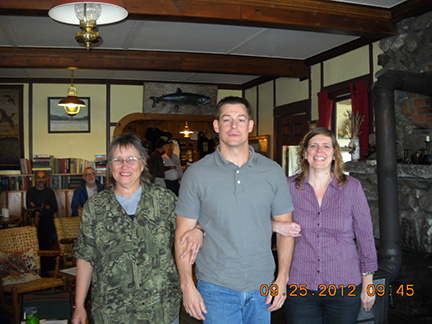
Former AIC Presidents Joan Trial and Kathryn Collet escort the newly-elected AIC President Graham Goulette.
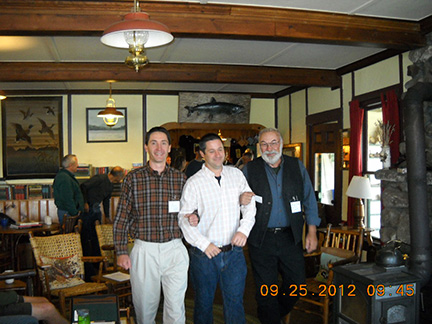
Former AIC Presidents Jud Kratzer and Angie Incerpi escort the newly-elected AIC Vice-President Michael Bailey.

Former AIC Presidents Ernie Atkinson and Phil Downey escort the newly-(re)elected AIC Secretary-Treasurer John Magee.

